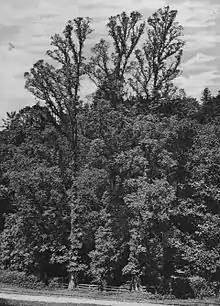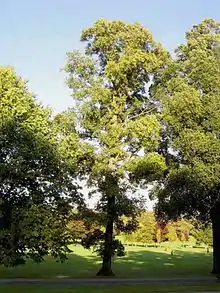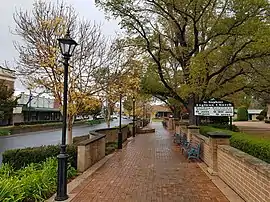Ulmus minor 'Stricta'
The field elm cultivar Ulmus minor 'Stricta', known as Cornish elm, was commonly found in South West England (Cornwall and West Devon) and Brittany until the arrival of Dutch elm disease in the late 1960s. The origin of Cornish elm in England remains a matter of contention. It is commonly assumed to have been introduced from Brittany.[1] It is also considered possible that the tree may have survived the ice ages on lands to the south of Cornwall long since lost to the sea.[2] Henry thought it "probably native in the south of Ireland".[3] Dr Max Coleman of Royal Botanic Garden Edinburgh, arguing in his 2002 paper on British elms that there was no clear distinction between species and subspecies, suggested that known or suspected clones of Ulmus minor, once cultivated and named, should be treated as cultivars, preferred the designation U. minor 'Stricta' to Ulmus minor var. stricta. The DNA of 'Stricta' has been investigated and the cultivar is now known to be a clone.[4]
| Ulmus minor 'Stricta' | |
|---|---|
 U. minor 'Stricta', Coldrenick, Cornwall, before 1913 | |
| Species | Ulmus minor |
| Cultivar | 'Stricta' |
| Origin | England |
Mature trees are now largely restricted to Australia, where it was introduced in the 19th century.[5][6]
Description
Growing to a height of up to 27 metres (89 ft) in sheltered situations (in exposed situations it is usually half the size),[7] the Cornish elm is a slender, slow-growing deciduous tree, distinguished by its long, straight trunk, which culminates in a narrow fan-shaped crown comprising short, straight, ascending branches.[8] The leaves are small, obovate to oval, typically acuminate at the apex, 6 cm long by 3.5 cm broad, with a dark-green upper surface, glossy and smooth. The perfect apetalous wind-pollinated flowers occur in clusters of 15–20 on very short pedicels. The samarae rarely ripen in England, but when mature are very similar to those of others in the field elm group, being mostly obovate, 16 mm long by 10 mm broad.
Dr Oliver Rackham (1986) noted that Cornish elms with "more spreading" crowns grow around Truro and on the Lizard Peninsula, illustrating the variety, which he called 'Lizard Elm', with a 1980 photograph.[9][10]
 Cornish elm, Hampstead Cemetery, 1912
Cornish elm, Hampstead Cemetery, 1912 Cornish elm in Preston Park, Brighton, 2005
Cornish elm in Preston Park, Brighton, 2005 'Stricta', Finistère, France, 1996
'Stricta', Finistère, France, 1996 Long-shoot leaves of Cornish elm, Penhalvean, Cornwall
Long-shoot leaves of Cornish elm, Penhalvean, Cornwall.jpg.webp) Short-shoot leaves of Cornish elm, Calton Hill Park, Edinburgh
Short-shoot leaves of Cornish elm, Calton Hill Park, Edinburgh%252C_Edinburgh.jpg.webp) Short-shoot leaves of Cornish elm
Short-shoot leaves of Cornish elm
Pests and diseases
Cornish elm is very susceptible to Dutch elm disease, but suckers remain a common component of hedgerows in parts of Cornwall, and thus the genetic resources of this cultivar are not considered endangered.[11] Like other field elms, propagation is almost entirely by suckers, which the tree produces copiously.[1][12]
Cultivation and uses

Cornish elm was traditionally considered the best shelter-belt tree along the Cornish coast. Its timber was much prized for its strength, and was commonly used in wheel and wagon construction.[13] Working Cornish pilot gigs were traditionally built from Cornish elm: the Rules of the Cornish Pilot Gig Association specified that to take part in gig races the boat should be made from "Cornish narrow-leaved elm".[14][15] Ley (1910) described Cornish elm as "abundant in Brittany, very abundant in West Cornwall, becoming less abundant in East Cornwall and West Devon".[7] Cornish elm was later cultivated as an ornamental tree in parts of southern England and southern Ireland, and, more rarely, in UK urban plantings. Hillier & Sons nursery, Winchester, Hampshire, was among the nurseries that supplied it, carefully distinguishing it from Wheatley elm.[16] The locations of notable plantings of Cornish elm, both in Cornwall and beyond, are listed in Henry (1913),[3] Richens (1983),[1] and Mitchell (1996).[17]
Few mature specimens are known to survive in the wild in England. Only one is known in Cornwall (see under 'Notable trees'), while about 18 reputedly grow in the Brighton & Hove enclave.[18] Another two have been reported (2009) from East Sussex at Selmeston, near the footpath across the grounds of Sherrington Manor.[19] Two specimens survive in Edinburgh (2019), an old tree in Dean Gardens,[20] and a younger by Greenside Church, Calton Hill.
The Wheatley or Guernsey elm (Ulmus minor 'Sarniensis') was often misnamed "Cornish elm" in the UK by the local authorities who planted it extensively.[21][22] Introduced to the US, Ulmus campestris cornubiensis, 'Cornish elm', appeared from the 1860s in catalogues of the Mount Hope Nursery (also known as Ellwanger and Barry) of Rochester, New York,[23][24] later catalogues distinguishing it from Wheatley Elm.[25] Cornish Elm also appeared separately from Wheatley Elm in the catalogues of the Perry Nursery Co. of Rochester, N.Y.[26]
'Stricta' is not known to remain in commerce beyond Australia.
Notable trees
The Great Elm of Rosuic, an ancient pollard elm which attained a d.b.h. of over 2.5 metres (8.2 ft) before succumbing to disease, continues to produce suckers.[27][28]
As of 2011, the Woodland Trust lists only one verified mature Cornish elm surviving in Cornwall, a specimen 1.89 metres (6.2 ft) in girth at Tregoose near Helston.[29] A small number of mature trees, with an average d.b.h. of 143 cm, survive at Castletownbere Cemetery in County Cork, Ireland.[30]
Old Cornish elms, spreading with age, their form also influenced by latitude, stand by St Stephen's Anglican Church, Mittagong, New South Wales, Australia.[6]
Synonymy
- U. cornubiensis Weston (1770)
- U. nitens var. stricta Aiton (1789)
- U. stricta Lindley (1829)
- U. campestris var. cornubiensis Loudon (1838)
- ?U. reticulata Dumort. stricta Dumort.[31]
- U. carpinifolia var. cornubiensis
Varieties
An Ulmus stricta parvifolia, a "less common" form of Cornish elm, was described by Lindley in A Synopsis of British Flora, arranged according to the Natural Order (1829), from trees in Cornwall and North Devon, with "leaves much smaller" than Cornish elm, "less oblique at the base, finely and regularly crenate" and "acuminate" rather than, as in Cornish elm, "cuspidate".[32][33] Melville considered Goodyer's elm a variety of Cornish elm. Some nurseries listed 'Dickson's Golden Elm' as form of Cornish elm.
Hybrids
It has been suggested that the cultivar 'Daveyi' is a natural hybrid of Wych elm and Cornish elm;[34][35] likewise 'Exoniensis'. The botanist F. J. Fontaine conjectured that the cultivar Ulmus 'Purpurea' is related to the Cornish elm.[36]
'Stricta'-like elms
An U. campestris cornubiensis (syn. U. glabra cornubiensis) was distributed by the Späth nursery, Berlin, in the late 19th century and early 20th. Henry stated that the "beautiful narrow pyramidal tree" he had seen by that name in Späth's nursery differed from true Cornish elm, bearing instead "leaves similar in size and appearance to a common form of U. nitens" [:U. minor].[37] One specimen of Späth's U. campestris cornubiensis was supplied to the Dominion Arboretum, Ottawa, Canada in 1897,[38] and three to the Royal Botanic Garden Edinburgh in 1902,[39] one being planted in the Garden proper and cultivated as U. stricta,[40] the other two being planted in the city. In 1958 Melville likewise queried Späth's Cornish elm (see External links below, herbarium specimen E00824799); Edward Kemp, however, RBGE curator (1950–71), accepted it.[41] A specimen of what appears from herbarium specimens to be the same clone survives (2016) in Edinburgh (height about 25 m, girth about 2 m), in Douglas Crescent Gardens.[42][43] The latter also matches an 1825 herbarium specimen labelled "U. suberosa var., Hort. Millburn".[44]
 Späth's U. campestris cornubiensis, Royal Botanic Garden Edinburgh
Späth's U. campestris cornubiensis, Royal Botanic Garden Edinburgh.jpg.webp) Douglas Crescent Gardens elm, Edinburgh
Douglas Crescent Gardens elm, Edinburgh.jpg.webp) Leaves of same
Leaves of same.jpg.webp) Bark
Bark.jpg.webp) Bole
Bole
In art
Landscape-paintings depicting Cornish elm include Holman Hunt's watercolour Helston, Cornwall (1860), showing hedgerow elms,[45][46] and the watercolour Egloshayle, Cornwall by Thomas Campbell-Bennett (1858-1948), showing Cornish elms beside the River Camel, opposite the church of St Mary, Egloshayle.[47] The latter illustrates Gerald Wilkinson's observation that "In its normal habitat the Cornish elm often has a flat, wind-cut top".[48]
Accessions
- North America
- Arnold Arboretum, US. Acc. no. 17676, and acc. no. 328-81 (two trees).
- Bartlett Tree Nurseries, US. Acc. no. 96–2161, details unavailable.
- J. C. Raulston Arboretum, North Carolina State University, US. Details unavailable.
- Europe
- Brighton & Hove City Council, UK. NCCPG Elm Collection.[18] 12 trees in Bear Road Cemetery, 2 in Hove Cemetery, 2 along Queen's Park Road, 1 along Buckingham Road, 1 at Benfield Valley (Hove Golf Course).
- Cambridge Botanic Garden,[49] University of Cambridge, UK. as U. angustifolia var. cornubiensis, no accession details available.
- Grange Farm Arboretum, Sutton St James, Spalding, Lincolnshire, UK. As U. minor subsp. angustifolia. Acc. no. 1079.
- Wijdemeren City Council, Netherlands. Elm collection. 2 planted at cemetery De Hornhof, Slotlaan, Nederhorst den Berg 2015 (cultivation Noordplant Nursery, Glimmen)
- Australasia
- Royal Botanic Gardens, Sydney, Australia.[50]
References
- Richens, R. H. (1983). Elm. Cambridge University Press
- White, J. & More, D. (2002). Trees of Britain & Northern Europe. Cassell's, London.
- Elwes, Henry John; Henry, Augustine (1913). The Trees of Great Britain & Ireland. 7. pp. 1891–1892.
- Coleman M. (2002) 'British elms.' British Wildlife 13 (6): 390–395.
- Spencer, R., Hawker, J. and Lumley, P. (1991). Elms in Australia. Australia: Royal Botanic Gardens, Melbourne. ISBN 0724199624.CS1 maint: multiple names: authors list (link)
- Spencer, Roger, ed., Horticultural Flora of South-Eastern Australia, Vol. 2 (Sydney, 1995), Ulmus, p. 113
- Ley, Augustin (1910). "Notes on British elms". Journal of botany, British and foreign. 48: 65–72. Retrieved 8 February 2018.
- Diagnostic photographs of Cornish elm in St Austell (Francis Frith Collection); at Coldrenick, Menheniot (Elwes and Henry, The Trees of Britain and Ireland vol.VII, Plate 397 [after p.1933]) ; in Zelah (oldcornwall.netfirms.com) Archived 2006-08-18 at the Wayback Machine.
- Rackham, Oliver, The History of the Countryside (London, 1986), p.236
- 'Stricta' from St Anthony-in-Meneage, Lizard Peninsula, bioportal.naturalis.nl, specimen L.1582352
- Ipgri.cgiar.org
- Stace, C. A. (1997). New Flora of the British Isles, 2nd edition. Cambridge University Press
- Elwes, H. J. & Henry, A. (1913). The Trees of Great Britain & Ireland. Vol. VII. 1848–1929. Republished 2004 Cambridge University Press, ISBN 9781108069380
- Cornish Pilot Gig Association, cpga.co.uk/
- Edwards, Ian, 'Uses of Elm Past and Present', in Coleman, Max, ed. Wych Elm (Edinburgh (2009), p.45
- Trees and Shrubs Catalogue, Hillier & Sons, 1958–1959, p.99
- Mitchell, Alan (1996). Alan Mitchell's Trees of Britain. London: HarperCollins. pp. 345–356. ISBN 0-00-219972-6.
- "List of plants in the {elm} collection". Brighton & Hove City Council. Retrieved 23 September 2016.
- South Downs Online
- "'Stricta' in Dean Gardens, Edinburgh". Google Maps. October 2016. Retrieved 2019-07-01.
- Mitchell, A. (1996) The Trees of Britain (London)
- Howes, C. A. (2007). Seaward, M. R. D. (ed.). "The Wheatley elm: A fading part of Yorkshire's arbocultural heritage?". The Naturalist. 132 (1060): 63–66.
- Ellwanger & Barry, Descriptive Catalogue of Hardy Ornamental Trees ... at the Mount Hope Nurseries (Rochester, N.Y., 1868), p.8
- Ellwanger & Barry, Descriptive Catalogue of Hardy Ornamental Trees ... at the Mount Hope Nurseries (Rochester, N.Y., 1875)
- Ellwanger & Barry, Descriptive Catalogue of Hardy Ornamental Trees ... at the Mount Hope Nurseries (Rochester, N.Y., 1899), p.63
- Illustrated and descriptive catalogue of fruit and ornamental trees, Perry Nursery Co., Rochester, N.Y., 1912, p.90
- "Ancient Trees in Cornwall (third paragraph)". Cornwall Council. February 17, 2010. Retrieved May 5, 2011.
Based on a chapter written by Sue Pring in 'Glorious Gardens of Cornwall' published by the Cornwall Gardens Trust.
- Rackham, Oliver, A History of the Countryside (London, 1986)
- Details and photographs of Tregoose elm. Ancient-tree-hunt.org.
- Mackenthun, G. L. (2007) The elms of Co. Cork - a survey of species, varieties and forms. Irish Forestry Vol 64, (1 & 2) 2007
- botanicalcollections.be specimen BR0000005422838
- Lindley, John (1829). A synopsis of the British Flora; arranged according to the Natural Orders. London. pp. 226–227. Retrieved 14 December 2017.
- Loudon, J. C., Hortus lignosus londinensis (London 1838), p.92-4
- http://www.cornwall.gov.uk/default.aspx?page=13849
- Archie Miles, Hidden Trees of Britain, Ebury Press, 2007, p.17
- F. J., Fontaine (1968). "Ulmus". Dendroflora. 5: 37–55. Retrieved 30 August 2017.
- Elwes & Henry (1913), p.1891
- Catalogue of the trees and shrubs in the arboretum and botanic gardens at the central experimental farm (2nd ed.). 1899. p. 75.
- Accessions book. Royal Botanic Garden Edinburgh. 1902. pp. 45, 47.
- RBGE Cultivated herbarium accessions book: Elms cultivated at Edinburgh Botanic Garden (1958), tree C2699
- A photograph of the RBGE 'Stricta' appears in Clouston, B., & Stansfield, K., eds. After the Elm (London 1979)
- Edinburgh 'Stricta' may be seen on Google Streetview, from 1 Douglas Gardens.
- Edinburgh 'Stricta' above Dean Village
- 1825 herbarium-specimen
- cornwallartists.org/cornwall-artists/william-holman-hunt
- Richens, R. H., Elm (Cambridge 1983), ch.8
- Egloshayle, Cornwall by Thomas Campbell-Bennett, antique-fine-art.com . The same trees in a 1920 photograph, 'Wadebridge, 1920', francisfrith.com: and in 1895, 'Wadebridge from Egloshayle, 1895', francisfrith.com:
- Wilkinson, Gerald, Epitaph for the Elm (London, 1978), p.70
- Cambridge Botanic Garden
- Spencer, R.; Hawker, J. & Lumley, P. (1991). Elms in Australia. Australia: Royal Botanic Gardens, Melbourne. ISBN 0-7241-9962-4.
- EstablishedTrees.com.au
External links
- Jobling & Mitchell, 'Field Recognition of British Elms', Forestry Commission Booklet
- "Herbarium specimen - L.1590640". Botany catalogues. Naturalis Biodiversity Center. Sheet described as var. stricta, "the prevailing elm about Trelissick and Truro" (1908)
- "Herbarium specimen - WAG.1853199". Botany catalogues. Naturalis Biodiversity Center. Sheet described as U. cornubiensis Kirchn. (Späth)
- "Herbarium specimen - E00824856". Herbarium Catalogue. Royal Botanic Garden Edinburgh. Sheet described as U. glabra cornubiensis [ = U. campestris cornubiensis from Späth nursery, 1902]
- "Herbarium specimen - E00824857". Herbarium Catalogue. Royal Botanic Garden Edinburgh. Sheet described as U. glabra cornubiensis [ = U. campestris cornubiensis from Späth nursery, 1902]
- "Herbarium specimen - E00824858". Herbarium Catalogue. Royal Botanic Garden Edinburgh. Sheet described as U. glabra cornubiensis [ = U. campestris cornubiensis from Späth nursery, 1902]
- "Herbarium specimen - E00824799". Herbarium Catalogue. Royal Botanic Garden Edinburgh. Sheet described as U. campestris cornubiensis from Späth nursery, 1902
- "Herbarium specimen - E00824736". Herbarium Catalogue. Royal Botanic Garden Edinburgh. Sheet (left hand side) described as U. stricta (1843 Royal Botanic Society specimen)
- "Herbarium specimen BR0000005422838". Botanic Garden, Meise. Sheet labelled Ulmus reticulata Dumort. stricta Dumort., re-labelled U. cornubiensis by Melville (juvenile leaves)

